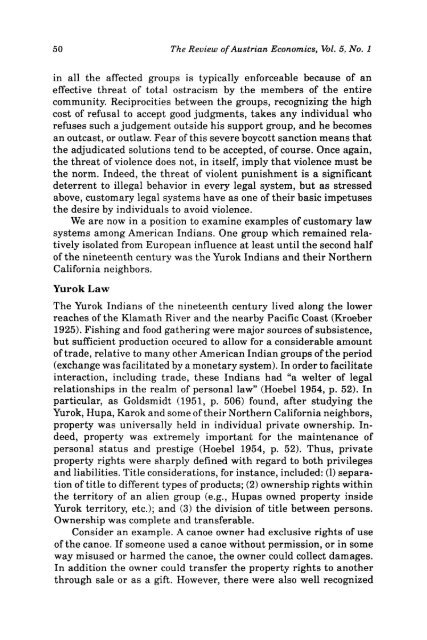Review of Austrian Economics - The Ludwig von Mises Institute
Review of Austrian Economics - The Ludwig von Mises Institute
Review of Austrian Economics - The Ludwig von Mises Institute
You also want an ePaper? Increase the reach of your titles
YUMPU automatically turns print PDFs into web optimized ePapers that Google loves.
50 <strong>The</strong> <strong>Review</strong> <strong>of</strong> <strong>Austrian</strong> <strong>Economics</strong>, Vol. 5, No. 1<br />
in all the affected groups is typically enforceable because <strong>of</strong> an<br />
effective threat <strong>of</strong> total ostracism by the members <strong>of</strong> the entire<br />
community. Reciprocities between the groups, recognizing the high<br />
cost <strong>of</strong> refusal to accept good judgments, takes any individual who<br />
refuses such a judgement outside his support group, and he becomes<br />
an outcast, or outlaw. Fear <strong>of</strong> this severe boycott sanction means that<br />
the adjudicated solutions tend to be accepted, <strong>of</strong> course. Once again,<br />
the threat <strong>of</strong> violence does not, in itself, imply that violence must be<br />
the norm. Indeed, the threat <strong>of</strong> violent punishment is a significant<br />
deterrent to illegal behavior in every legal system, but as stressed<br />
above, customary legal systems have as one <strong>of</strong> their basic impetuses<br />
the desire by individuals to avoid violence.<br />
We are now in a position to examine examples <strong>of</strong> customary law<br />
systems among American Indians. One group which remained relatively<br />
isolated from European influence at least until the second half<br />
<strong>of</strong> the nineteenth century was the Yurok Indians and their Northern<br />
California neighbors.<br />
Yurok Law<br />
<strong>The</strong> Yurok Indians <strong>of</strong> the nineteenth century lived along the lower<br />
reaches <strong>of</strong> the Klamath River and the nearby Pacific Coast (Kroeber<br />
1925). Fishing and food gathering were major sources <strong>of</strong> subsistence,<br />
but sufficient production occured to allow for a considerable amount<br />
<strong>of</strong> trade, relative to many other American Indian groups <strong>of</strong> the period<br />
(exchange was facilitated by a monetary system). In order to facilitate<br />
interaction, including trade, these Indians had "a welter <strong>of</strong> legal<br />
relationships in the realm <strong>of</strong> personal law" (Hoebel 1954, p. 52). In<br />
particular, as Goldsmidt (1951, p. 506) found, after studying the<br />
Yurok, Hupa, Karok and some <strong>of</strong> their Northern California neighbors,<br />
property was universally held in individual private ownership. Indeed,<br />
property was extremely important for the maintenance <strong>of</strong><br />
personal status and prestige (Hoebel 1954, p. 52). Thus, private<br />
property rights were sharply defined with regard to both privileges<br />
and liabilities. Title considerations, for instance, included: (1) separation<br />
<strong>of</strong> title to different types <strong>of</strong> products; (2) ownership rights within<br />
the territory <strong>of</strong> an alien group (e.g., Hupas owned property inside<br />
Yurok territory, etc.); and (3) the division <strong>of</strong> title between persons.<br />
Ownership was complete and transferable.<br />
Consider an example. A canoe owner had exclusive rights <strong>of</strong> use<br />
<strong>of</strong> the canoe. If someone used a canoe without permission, or in some<br />
way misused or harmed the canoe, the owner could collect damages.<br />
In addition the owner could transfer the property rights to another<br />
through sale or as a gift. However, there were also well recognized

















